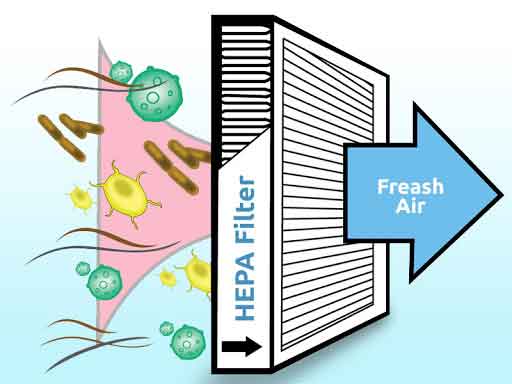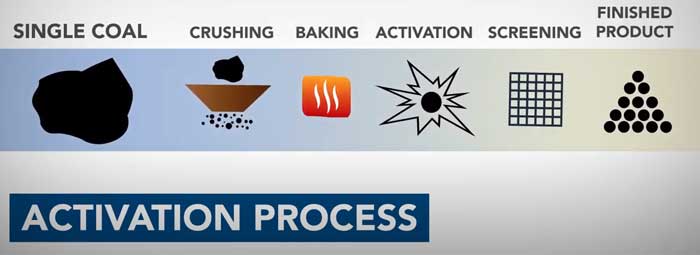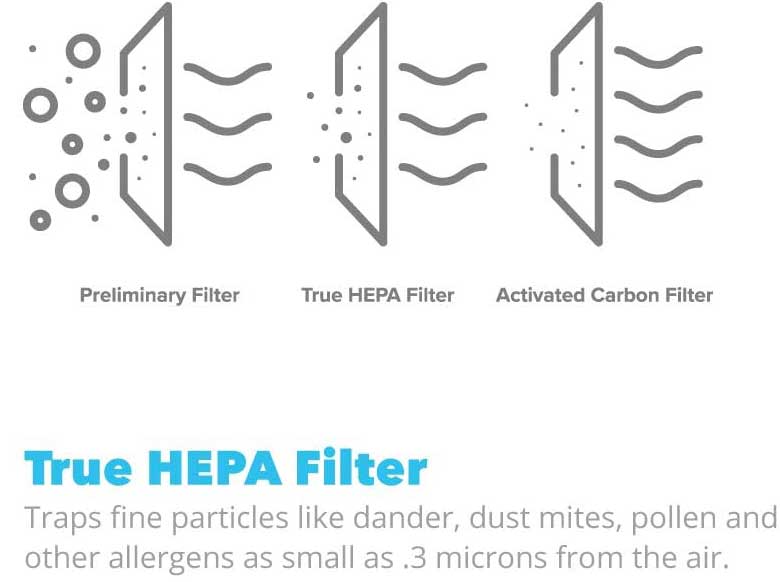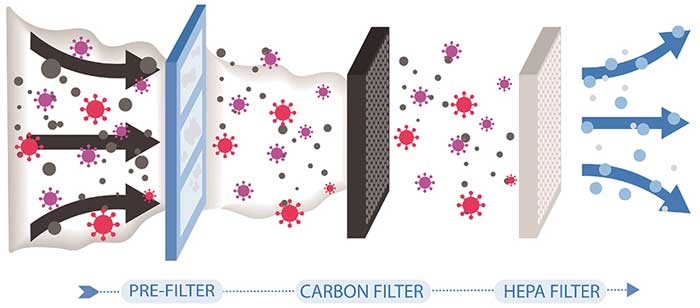The idea of having an air purifier in your home is very enticing, given that this appliance is designed to clean indoor air of harmful and irritating airborne pollutants. Despite the widely advertised promises, some people wonder whether air purifiers are reliable?
Below you will learn how air purifiers work and to what extent.
What is an Air Purifier?
Before diving into whether air purifiers work or not, you will want to understand what they are!
Basically, simple way to explain air purifiers is to compare them with vacuum cleaners; just like vacuum cleaner cleans the floor or carpet, air purifier remove airborne pollutants from the indoor environment. And this is achieved by drawing air, extracting the contaminants, and returning it to the indoor space.
An air purifier consists of a fan and a filter. The fan pulls the air and blows it over the filter where the pollutants are captured and retained.
Some air purifiers come with more than one filter. And there are also advanced air purifiers that use state-of-the-art technology enabling them to extract or even destroy the tiniest impurities.
These advanced technologies includes oxygen generators, electric ions, photochemical reactors, and carbon absorbents.
Do Air Purifiers Work?
The simple answer to this question is YES!
But there are limitations to the level of purification and the type of pollutants a specific air purifier can handle.
Here is a rundown on different air filtration mechanisms that currently exists among air purifiers and how they work:
Pre-Filter
Most air purifiers come with pre-filters that capture large and visible air pollutants like dust, hair, and lint. These filters are normally located between the air grille and the other filters, creating the first line of defense.
Pre-filters are extremely important as they prevent the other filters from clogging prematurely. They are mostly made of plastic, making them very durable.
HEPA Filter
HEPA filters comprise a dense fiber weave that traps the tiny particles passing through the pre-filter. These filters can trap 99.7% of indoor air pollutants as small as 0.3 microns.
In essence, the HEPA filter is tasked with eliminating pollen, pet dander, mold spores, and smoke particles. Some HEPA filters also boast anti-microbial properties that neutralize organic pollutants like mold and bacteria.
RELATED: If you are interested in learning more about HEPA Filter then check out this guide.

Activated Carbon Filter
Activated carbon filters have a layer of activated carbon these filters are built with basically charred wood or charcoal that’s molded to create a filter. They are extremely porous, enabling them to attract and absorb odors, VOCs, toxic gases, and smoke.
RELATED: If you are interested in learning more about Activated Carbon Filter then check out this guide.

Activated Carbon Filter Creation Process
Activated carbon filters can not be cleaned or reused they should be replaced after use.
Photocatalytic Purification
This is an advanced air purification mechanism that cleans indoor atmosphere by converting pollutants into harmless substances. It works by combining UVC irradiation with titanium dioxide, transforming impurities into water, detritus, and carbon dioxide.
This process occurs in specially designed chambers in air purifier. In most units, this function is optional and comes with an ON/OFF button.
Ion Generator
Also known as an ionizer, an ion generator produces static energy that charges airborne contaminants. The charge forces the pollutants to stick together, making them heavy enough to fall to the ground or attach to the nearest surfaces. Some air purifiers also come with collector plates that draw pollutants and trap them on their surface.
Air ionizers are especially ideal for workshops or factories where the air constantly gets polluted by particle pollutants.
- NOTE: Ionizers can generate ozone, which is hazardous to our respiratory system. We recommend using them in short intervals to prevent ozone buildup. This is why air purifiers with ion generators feature ON/Off buttons, making the use of ionizers optional.
Photo Electrochemical Oxidation (PECO)
Air purifiers with this feature are capable of trapping and destroying pollutants to prevent re-circulation. This mechanism shines a light on the filter, activating a catalytic reaction to destroy organic pollutants like mold and VOCs at a molecular level.
While this feature turns pollutants into harmless substances, the filter still requires regular replacement. Besides, the non-organic pollutants can clog it up, thus preventing catalysts from getting activated.
Ozone Generators
Ozone generators come in handy in neutralizing airborne pollutants. However, this air cleaning method should be used on a professional level as it can be toxic.
Health Experts expressly discourage people from using ozone generators in their homes.
- Most household air purifiers feature three mechanical levels of filtration, including the pre-filter, HEPA, and carbon-activated filter. These filters go a long way in extracting the various-sized air pollutants commonly found in indoor atmosphere.

Commonly Available Household Air Purifiers Filtering System
Factors Contributing to Air Purifier Efficiency
Air purifiers do work, but you need to select a suitable unit depending on your home’s size and purification needs.
If you choose an air purifier carelessly, you might end up running your unit for days on end without experiencing significant changes in the atmosphere.
Select the Right Type
An air purifier’s efficiency is largely dependent on its method of purification. For instance, a HEPA air purifier comes with an effective filter that effortlessly eliminates almost 100% of indoor pollutants. It can also trap microscopic microns as small as 0.3-0.1 microns. As such, finding the right air cleaner entails first determining the type of pollutants in indoor environment. These may include smoke, odors, allergens, dust, chemicals, or gases.
A standard household should consider an air purifier that comes with following filters (Minimum Standard):
- Pre-filter for hair, dust, and lint
- HEPA filter for pollen, pet dander, dust mites, mold, and bacteria
- Carbon filter for eliminating VOCs, odors, smoke, and toxic gases

In spaces where particle pollution is an issue, you’re better off with an ionizer or photocatalytic purifiers. You may also go for PECO air purifiers if you’re struggling with organic pollutants.
Select the Right Size
Air Exchange Rate also known as Air Changes per Hour abbreviated ACH or ACPH is a measurement of how many times a volume of air within the space/room is removed, added or simply exchanged.
ACH or ACPH can help size the air purifier that should be used give the volume of the space. You can learn more about how ACH is calculated in our detail guide.
How to calculate ACPH “Air Changes/Hour”
Formula: ![]()
Parameters:
Q = CFM (Cubic Feet per Minute) of Air Purifier
V = Volume of the Room Length x Width x Height in (Cubic Feet)
For example, if you are looking to purchase an air purifier for a bedroom following calculation can be used.
In this example, we used LVH-134 one of Levoit’s air purifier. You can learn more about CADR in our complete guide.
Parameters:
Air Purifier Clean Air Delivery Rate (CADR) = 312 CFM
Bedroom Volume = 15 x 10 x 8 = 1200 Cubic Feet
Calculation:
ACPH = (60 x 312) / 1200 = 15.5 Total Number of Room Air Changes Per Hour
As you can see, Levoit LVH-134 can be used for 1200 cubic feet room since the ACPH value is 2x the minimum recommendation.
Below table includes the minimum recommended ACPH for each type of space, these values are used in ventilation design. And can be use to size an air purifier.
| AIR CHANGES RATE / HOUR (ACPH) MINIMUM RECOMMENDATION | ||||||||||||||||||||||||||||||||||||||||||||||||||
|---|---|---|---|---|---|---|---|---|---|---|---|---|---|---|---|---|---|---|---|---|---|---|---|---|---|---|---|---|---|---|---|---|---|---|---|---|---|---|---|---|---|---|---|---|---|---|---|---|---|---|
| ||||||||||||||||||||||||||||||||||||||||||||||||||
Tip: Typically most vendors provide coverage areas their unit is able to handle. And these values are certified by AHAM (Association of Home Appliance Manufacturers).
How to Maintain an Air Purifier’s Optimal Performance
The effectiveness of an air purifier, whether standard or high-end, is largely dependent on your commitment to improving indoor air quality.
Check out the following pro tips for enhancing your unit’s performance:
Keep Your House Clean
All your efforts to clean indoor atmosphere are futile if your house is dirty. Air purifiers only remove airborne pollutants; they can’t eliminate the dirt resting on the surfaces like flooring, carpet or table.
Following are recommended ways:
- Vacuum the carpets and upholstery regularly
- Bath and comb pets often
- Avoid smoking in the house
- Switch to non-toxic detergents
- Replace area rugs and carpets with hard floors or vinyl, especially if a family member has respiratory allergy or asthma
- Regulate indoor humidity with dehumidifiers and humidifiers
By undertaking the above tasks, you will enable your air purifier to deal with new and lingering pollutants, effectively keeping your indoor environment pollution-free.
Adhere to Basic Maintenance Routines
Ensuring that air purifier runs on a clean filter is a critical step in maintaining its efficiency. Air filters will often lose their effectiveness due to the accumulation of airborne debris on their surface. As such, you need to wash or replace air filters promptly.
- It’s best to wash pre-filter at least once a month or when you feel like your unit is struggling to exchange air. You can test the airflow by placing your hand over the exhaust grille.
- HEPA and Carbon filters are not washable, replace them when the filter-change alert light illuminates or as recommended by the manufacturer.
- It’s also advisable to discard the filters after using air purifier in a mold-infested environment to prevent re-circulation.
- If air purifier lacks an air filter, check the user manual to see what parts require cleaning. For instance, electrostatic air purifiers require you to clean on their dust collector plates.
- Besides cleaning the filters, it’s advisable to dust the air intake and exhaust grilles to ensure efficient airflow.
- NOTE: Follow manufacturer filter replacement guidelines for optimal usage.
Close the Door and Windows
Open windows and doors are among the reasons why some people complain that they don’t see a significant change in their indoor atmosphere even after running an air purifier. But how can you feel the effects of using an air purifier while the clean air is constantly escaping to the outdoors through these openings?
Besides, unclean air could be making its way into your home, frustrating your unit’s efforts to keep indoor atmosphere clean. To prevent this, you will want to seal all the entry and ventilation areas before running your unit.
Pro Tip: We recommended opening your doors and windows during the day for enhanced air circulation. However, ensure that they’re all closed when running your air purifier. Ideally, run your air cleaner at night to breathe clean air while sleeping. You may also run it when you’re away from the house so that you can come back home to a clean environment.
Ensure Proper Placement
Be mindful of where you place your air purifier; its position contributes significantly to its effectiveness.
As a general rule of thumb, there shouldn’t be any obstruction around air purifier when it’s running. This means that you should avoid placing the machine in a corner or near the wall, appliances, or furniture. Eliminating obstructions will enable the unit to draw and exhaust air effectively.
You may also consider the following placement ideas:
Place Air Purifier Near the Source of Pollution
For quick and optimal results, consider installing the unit near the source of air contamination. For instance, you may place it in the kitchen if you’re contemplating combating cooking-related smoke or odors. You can also put it in areas with visible mold growth.
Place It Off the Floor
Indoor air circulates in both horizontal and vertical directions. As such, it’s advisable to place your air purifier about three-four feet above the floor to ensure comprehensive purification. This will essentially allow the unit to draw and exhaust air efficiently; you can, therefore, expect cleaner air quicker.
Besides, placing the machine above the ground will ensure that the exhaust air doesn’t disturb surface pollutants on the floor, which would otherwise render them airborne and defeat the whole air cleaning idea.
Avoid High-Humid Areas
Humidity makes the air heavier, meaning that air purifier might struggle to draw or exhaust the air. Excess moisture also exposes the filters to untimely damage or even mold growth.
With that in mind, you need to avoid placing the unit in a highly humid kitchen. Also, refrain from using it in your bathrooms after a shower.
Since these rooms also require air cleaning, you need to get rid of the moisture before running your unit. Consider running a dehumidifier before attempting air purification.
Move the Machine Around
Air purifiers are portable, which is a good thing. Instead of placing your unit in one spot and expecting it to clean your entire indoor environment, consider moving it from one spot to another.
While at it, ensure to give the unit sufficient time to remove all pollutants from a specific space. Air purifiers with pollutant level indicators would come in handy in this situation.
The Bottom Line
Given that indoor air pollutants are two to five times higher than those in the outdoor atmosphere, we understand the high demand for air purifiers. These machines trap or even destroy airborne contaminants to provide you with a clean and healthy indoor environment. Air purifiers top the list when counting appliances that significantly improve your indoor air quality.
Despite the air purifiers’ ability to provide clean air, it’s not surprising to find users complaining that these devices aren’t as effective as advertised. On the flip side, you will also find other people wondering how they survived without an air purifier in their home. The disparity between the two opposing opinions is based on several factors.
Such include your choice when purchasing a unit, especially regarding appliance size and type. You must select a unit whose capacity and features can handle your home size and type of pollution. Also, remember to provide proper maintenance for your unit for enhanced efficiency and longevity. Appropriate placement also contributes significantly to your air purifier’s performance.
You will also want to clean your home often; don’t expect your air purifier to eliminate surface dirt. While proper ventilation goes a long way in improving air circulation, don’t forget to keep those windows and doors closed while running your appliance, lest you overwork the unit and fail to achieve your desired results.
